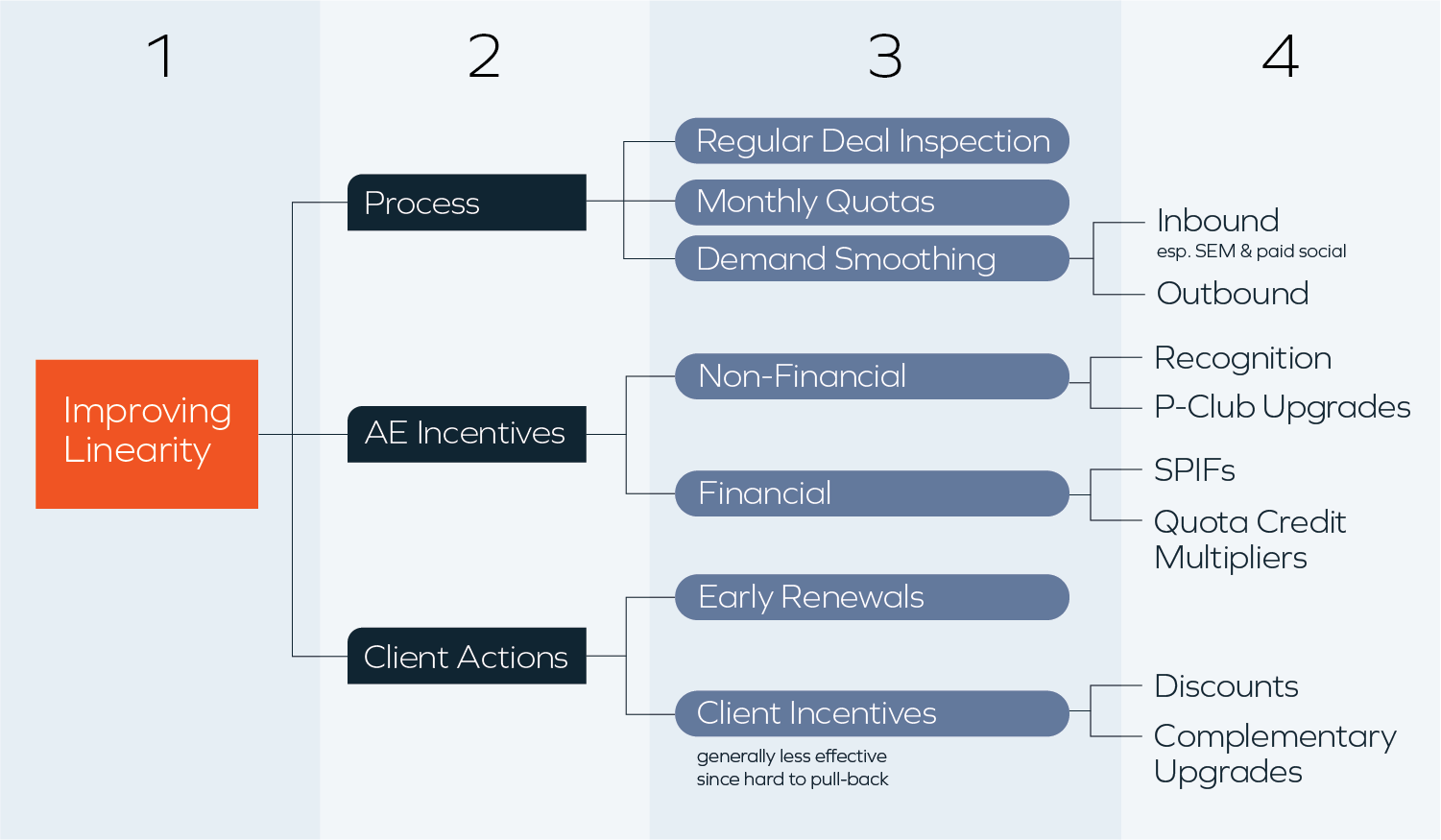
Every sales organization is hyper-focused on achieving its overall booking goals for a given period. However, far too many organizations find their bookings are jammed up on the last day of the last week of the last month of the last quarter of the year. The antidote to this problem is sales linearity, which ensures deals get closed smoothly over the course of the year.
Sales linearity is not only focused on the speed and consistency of deals over a measurable timeframe. It also is key to sales planning and forecasting, since leaders must know which segments are over-and under-performing prior to making additional investments in their revenue organizations.
Here we provide a set of options to help you build sales linearity into your revenue engine.
Process Improvements
1. Instill Pipeline Discipline
All too many sales leaders take it as a given that they need to get more involved and/or turn up the heat at the end of the quarter. Consequently, they become principle contributors to non-linearity.
Instead, sales leaders should inspect deals on a disciplined, weekly cadence. Managers must check deal health. This includes every MEDDICC factor every time, the opportunity amount, and the close date. Managers must constructively confront representatives whose closing dates are pegged to the last day of the quarter or the first day of the following quarter.
2. Move to Monthly Quotas
If the sales organization follows quarterly quotas, then non-linearity should come as no surprise. Moving to monthly quotas is a viable solution but does come with added planning overhead. This is because it requires resetting incentives and accelerators at a faster cadence and in the face of stronger seasonality.
3. Demand Smoothing – Inbound
For companies with tightly distributed sales cycles (relatively rare), the solution to non-linearity starts with ensuring top-of-funnel marketing expenditure to drive inbound leads from search engine marketing (SEM) or social advertising is more smoothly distributed.
4. Demand Smoothing – Outbound
Sales teams routinely fall into a vicious cycle of prospecting heavily during the first month of each quarter, achieving a healthy mix of prospecting and advancing deals in the second month, and then focusing almost exclusively on closing in the final month.
Echoing the process discipline discussed above, sales managers and leaders are responsible for inspecting the entire pipeline for each rep on a regular basis.
[Caveat: Managers cannot simply demand that representatives create a certain number of operations per week or month since that will simply inject garbage into the pipeline and lower win rates.]
Sales Incentives
5. Recognition
Sales professionals are both extrinsically and intrinsically motivated. Handing out quarterly linearity awards (independent of financial benefits) can have a powerful impact.
6. P-Club Upgrades
President’s or Achiever’s or Chairperson’s Club – aka Winner Circle – qualification is a powerful motivator for salespeople. They not only get bragging rights with colleagues, friends, and on their résumé but also can show off for their “plus-one.” While one does not want to create too much P-Club incentive complexity, one idea is to link linearity to various upgrades such as first-class airplane tickets or rooms with a view.
7. SPIFs
Pay for your linearity. Consider offering either fixed cash amounts or experiences (dinner for two, event tickets, etc.) for deals that close in the first or second month of the quarter.
8. Quota Credit Multipliers or Added Commission
Rather than fixed amounts, you can offer quota credit multipliers for added commission on deals that close earlier in the quarter. This is ranked slightly lower than SPIFs since fixed amounts or gifts are easier to administer. However, an added benefit of this idea is that it is easier to increase the incentive by month. For instance, one could give a 1.5x multiplier or +3% commission in month one, then a 1.25x multiplier or +1.5% commission in month two.
Gainsight’s Caitlin Quinlan, SVP of Revenue Operations, and Jeff Depa, Chief Revenue Officer, shared a highly successful pacing strategy their team applied that dramatically smoothed bookings: If a sales executive achieves at least 50% of their quarterly quota by the end of the second month, then they move into accelerators on their remaining attainment for the period. To prevent sellers who have not achieved the threshold from pushing deals into the following quarter, Gainsight only pays the accelerated rate on deals with sales cycles shorter than a set limit.
Client Actions
9. Early Renewals with New End Dates
As businesses mature, they often drive a substantially higher percentage of bookings from expansion of existing relationships than they do from new business. Seeking early renewals with new end dates for healthy clients and/or those seeking mid-contract upgrades offers an attractive way to improve linearity. A related, albeit unconventional, alternative would be to renew clients with 13-month or 14-month contracts.
10. Upgrades
Accelerating urgency by offering a complimentary product or service upgrade often works in more transactional selling situations with shorter sales cycles. However, if your sales cycle is long or your process is complex, be aware that it is close to impossible to pull back a “freebie” once offered.
11. Discounts
Offering financial discounts is another way to improve linearity; however, it should be viewed as a last option. As with upgrades, these are difficult to rescind without creating animosity. Worse, discounts run counter to value-selling and tend to contract margins more than complimentary upgrades do. Similar to the 13- or 14-month contract idea mentioned above, one could offer “14 for 12” contracts in month one of a quarter and/or “13 for 12” contracts in month two. In other words, buy 12 months and get 1 or 2 months free.
Final Thoughts
By applying one or more of the 11 concepts above, based on which is most suitable to your organization, you will enhance your sales linearity. If linearity incentives are too strong, representatives can become pushy, which destroys trust and can scuttle deals. Proceed mindfully.













